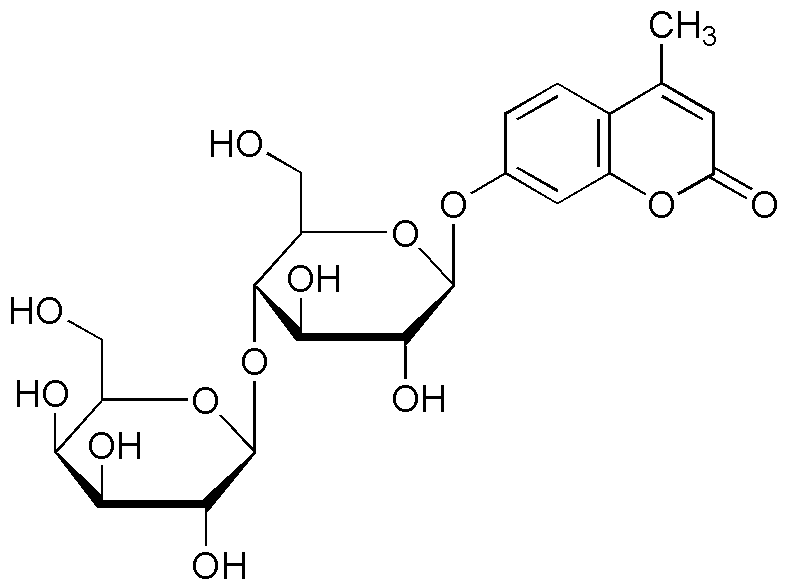4-Methylumbelliferyl-b-D-lactoside is widely utilized in research focused on:
- Enzyme Activity Assays: This compound is commonly used as a substrate in enzyme assays to measure the activity of β-galactosidase. Its fluorescence upon hydrolysis allows for sensitive detection, making it invaluable in biochemical research.
- Microbial Identification: It serves as a selective substrate for identifying specific bacteria, particularly in clinical microbiology. The ability to detect enzyme activity helps in the rapid identification of pathogens.
- Cell Biology Studies: Researchers use this compound to study cellular processes involving glycosylation. Its application in live-cell imaging provides insights into cellular functions and interactions.
- Drug Development: In pharmaceutical research, it aids in screening for compounds that can modulate enzyme activity, which is crucial for developing new therapeutic agents targeting glycosylation-related diseases.
- Food Industry Applications: It is also applied in food science to assess the quality and safety of dairy products by detecting lactose levels, helping ensure compliance with health standards.
General Information
Properties
Safety and Regulations
Applications
4-Methylumbelliferyl-b-D-lactoside is widely utilized in research focused on:
- Enzyme Activity Assays: This compound is commonly used as a substrate in enzyme assays to measure the activity of β-galactosidase. Its fluorescence upon hydrolysis allows for sensitive detection, making it invaluable in biochemical research.
- Microbial Identification: It serves as a selective substrate for identifying specific bacteria, particularly in clinical microbiology. The ability to detect enzyme activity helps in the rapid identification of pathogens.
- Cell Biology Studies: Researchers use this compound to study cellular processes involving glycosylation. Its application in live-cell imaging provides insights into cellular functions and interactions.
- Drug Development: In pharmaceutical research, it aids in screening for compounds that can modulate enzyme activity, which is crucial for developing new therapeutic agents targeting glycosylation-related diseases.
- Food Industry Applications: It is also applied in food science to assess the quality and safety of dairy products by detecting lactose levels, helping ensure compliance with health standards.
Documents
Safety Data Sheets (SDS)
The SDS provides comprehensive safety information on handling, storage, and disposal of the product.
Product Specification (PS)
The PS provides a comprehensive breakdown of the product’s properties, including chemical composition, physical state, purity, and storage requirements. It also details acceptable quality ranges and the product's intended applications.
Certificates of Analysis (COA)
Search for Certificates of Analysis (COA) by entering the products Lot Number. Lot and Batch Numbers can be found on a product’s label following the words ‘Lot’ or ‘Batch’.
*Catalog Number
*Lot Number
Certificates Of Origin (COO)
This COO confirms the country where the product was manufactured, and also details the materials and components used in it and whether it is derived from natural, synthetic, or other specific sources. This certificate may be required for customs, trade, and regulatory compliance.
*Catalog Number
*Lot Number
Safety Data Sheets (SDS)
The SDS provides comprehensive safety information on handling, storage, and disposal of the product.
DownloadProduct Specification (PS)
The PS provides a comprehensive breakdown of the product’s properties, including chemical composition, physical state, purity, and storage requirements. It also details acceptable quality ranges and the product's intended applications.
DownloadCertificates of Analysis (COA)
Search for Certificates of Analysis (COA) by entering the products Lot Number. Lot and Batch Numbers can be found on a product’s label following the words ‘Lot’ or ‘Batch’.
*Catalog Number
*Lot Number
Certificates Of Origin (COO)
This COO confirms the country where the product was manufactured, and also details the materials and components used in it and whether it is derived from natural, synthetic, or other specific sources. This certificate may be required for customs, trade, and regulatory compliance.


